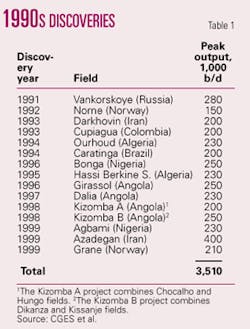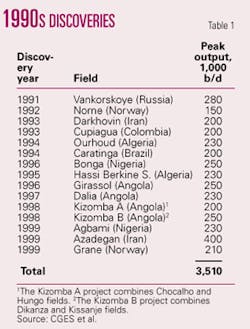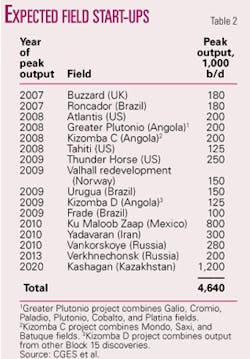The world has continued to discover giant oil fields, says a report by the Centre for Global Energy Studies, London.
The finding torpedoes several holdings by the advocates of “peak oil”: that the industry has not been finding enough oil, has been relying on too few aging oil fields, and has not been discovering new giants.
CGES compiled figures that show 17 giant oil discoveries in the 1950s, 29 in the 1960s, 24 in the 1970s, 15 in the 1980s, and 11 in the 1990s. Four of the fields found in recent decades are supergiants, CGES points out.
Nevertheless, it reports that 20% of global oil production comes from the world’s largest 14 fields and that the large fields found in the 1990s produce only one-tenth of the oil produced by 36 giant fields discovered more than 40 years ago.
CGES counted 15 giant discoveries in the 1990s (Table 1). Four of these are in deep water off Angola, and two are onshore in Iran.
The four relatively recent supergiant discoveries are Cantarell off Mexico, Tengiz and Kashagan in Kazakhstan, and Azadegan in Iran.
Politics and bureaucratic red tape are preventing the speedy development of Iran’s Azadegan and Darkhovin fields, CGES noted, and Kashagan, discovered in 2000, has not been developed because of quarrels over who would act as operator. With Italy’s Eni now chosen, Kashagan still isn’t scheduled to start producing until 2010.
A CGES list of large oil fields set to come on stream in 2007-20 (Table 2) excludes the emerging prospects of the Gulf of Mexico Lower Tertiary Trend (see map, OGJ, Sept. 25, 2006, p. 36). Twelve confirmed Lower Tertiary discoveries are thought to contain 3-15 billion bbl of recoverable reserves.
Output of 415,000 b/d at Mexico’s Ku Maloob Zaap field in the gulf is expected to climb to 800,000 b/d by 2010, partly offsetting Cantarell’s decline.
It is not correct to say that large discoveries are becoming scarce, CGES said.
Large fields discovered since 1976 are expected to have supplied 60% of the 19.5 million b/d of incremental demand in 1976-2010, it calculated.
“Another Saudi Arabian Ghawar field (over 90 billion bbl of recoverable oil) or a Kuwaiti Burgan (over 60 billion bbl) may not have been discovered, but the world has found many giant, and some mammoth, fields that add up to a massive amount of oil,” CGES said.




